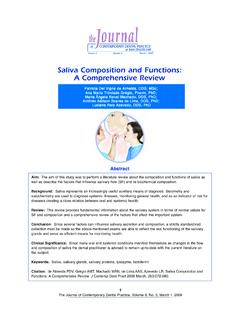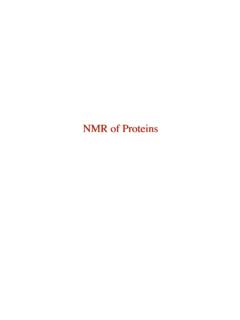Transcription of C 19 XCRETORY P THEIR LIMINATION - NCERT
1 290 BIOLOGYA nimals accumulate ammonia, urea, uric acid, carbon dioxide, waterand ions like Na+, K+, Cl , phosphate, sulphate, etc., either by metabolicactivities or by other means like excess ingestion. These substances haveto be removed totally or partially. In this chapter, you will learn themechanisms of elimination of these substances with special emphasis oncommon nitrogenous wastes. Ammonia, urea and uric acid are the majorforms of nitrogenous wastes excreted by the animals. Ammonia is themost toxic form and requires large amount of water for its elimination,whereas uric acid, being the least toxic, can be removed with a minimumloss of process of excreting ammonia is Ammonotelism. Many bony fishes,aquatic amphibians and aquatic insects are ammonotelic in , as it is readily soluble, is generally excreted by diffusion acrossbody surfaces or through gill surfaces (in fish) as ammonium ions.
2 Kidneysdo not play any significant role in its removal. Terrestrial adaptationnecessitated the production of lesser toxic nitrogenous wastes like ureaand uric acid for conservation of water. Mammals, many terrestrialamphibians and marine fishes mainly excrete urea and are called ureotelicanimals. Ammonia produced by metabolism is converted into urea in theliver of these animals and released into the blood which is filtered andexcreted out by the kidneys. Some amount of urea may be retained in thekidney matrix of some of these animals to maintain a desired , birds, land snails and insects excrete nitrogenous wastes as uricacid in the form of pellet or paste with a minimum loss of water and arecalled uricotelic PRODUCTS ANDTHEIR ELIMINATIONCHAPTER of ofConcentration ofthe ofKidney of otherOrgans of theExcretorySystem2015-16(19/01/2015)EXC RETORY PRODUCTS AND THEIR ELIMINATION291A survey of animal kingdom presents a variety of excretory most of the invertebrates, these structures are simple tubular formswhereas vertebrates have complex tubular organs called kidneys.
3 Someof these structures are mentioned here. Protonephridia or flame cells arethe excretory structures in Platyhelminthes (Flatworms, , Planaria),rotifers, some annelids and the cephalochordate are primarily concerned with ionic and fluid volumeregulation, , osmoregulation. Nephridia are the tubular excretorystructures of earthworms and other annelids. Nephridia help to removenitrogenous wastes and maintain a fluid and ionic balance. Malpighiantubules are the excretory structures of most of the insects includingcockroaches. Malpighian tubules help in the removal of nitrogenouswastes and osmoregulation. Antennal glands or green glands performthe excretory function in crustaceans like HUMAN EXCRETORY SYSTEMIn humans, the excretory system consistsof a pair of kidneys, one pair of ureters, aurinary bladder and a urethra ( ). Kidneys are reddish brown, beanshaped structures situated between thelevels of last thoracic and third lumbarvertebra close to the dorsal inner wall ofthe abdominal cavity.
4 Each kidney of anadult human measures 10-12 cm inlength, 5-7 cm in width, 2-3 cm inthickness with an average weight of 120-170 g. Towards the centre of the innerconcave surface of the kidney is a notchcalled hilum through which ureter, bloodvessels and nerves enter. Inner to the hilumis a broad funnel shaped space called therenal pelvis with projections called outer layer of kidney is a toughcapsule. Inside the kidney, there are twozones, an outer cortex and an innermedulla. The medulla is divided into a fewconical masses (medullary pyramids)projecting into the calyces (sing.: calyx).The cortex extends in between theFigure Human Urinary system2015-16(19/01/2015)292 BIOLOGYF igure diagrammatic representation of a nephron showing blood vessels,duct and tubulemedullary pyramids as renal columns calledColumns of Bertini (Figure ).Each kidney has nearly one millioncomplex tubular structures called nephrons(Figure ), which are the functional nephron has two parts theglomerulus and the renal is a tuft of capillaries formed bythe afferent arteriole a fine branch of renalartery.
5 Blood from the glomerulus is carriedaway by an efferent renal tubule begins with a doublewalled cup-like structure called Bowman scapsule, which encloses the alongwith Bowman s capsule, iscalled the malpighian body or renalcorpuscle (Figure ). The tubulecontinues further to form a highly coilednetwork proximal convoluted tubuleFigure section (Diagrammatic)of Kidney2015-16(19/01/2015)EXCRETORY PRODUCTS AND THEIR ELIMINATION293(PCT). A hairpin shaped Henle s loop is thenext part of the tubule which has adescending and an ascending limb. Theascending limb continues as another highlycoiled tubular region called distalconvoluted tubule (DCT). The DCTs of manynephrons open into a straight tube calledcollecting duct, many of which converge andopen into the renal pelvis through medullarypyramids in the Malpighian corpuscle, PCT and DCTof the nephron are situated in the corticalregion of the kidney whereas the loop of Henledips into the medulla.
6 In majority ofnephrons, the loop of Henle is too short andextends only very little into the medulla. Suchnephrons are called cortical nephrons. Insome of the nephrons, the loop of Henle isvery long and runs deep into the nephrons are called juxta efferent arteriole emerging from the glomerulus forms a finecapillary network around the renal tubule called the peritubularcapillaries. A minute vessel of this network runs parallel to the Henle sloop forming a U shaped vasa recta. Vasa recta is absent or highlyreduced in cortical FORMATIONU rine formation involves three main processes namely, glomerularfiltration, reabsorption and secretion, that takes place in different parts ofthe first step in urine formation is the filtration of blood, which is carriedout by the glomerulus and is called glomerular filtration. On an average,1100-1200 ml of blood is filtered by the kidneys per minute which constituteroughly 1/5th of the blood pumped out by each ventricle of the heart in aminute.
7 The glomerular capillary blood pressure causes filtration of bloodthrough 3 layers, , the endothelium of glomerular blood vessels, theepithelium of Bowman s capsule and a basement membrane between thesetwo layers. The epithelial cells of Bowman s capsule called podocytes arearranged in an intricate manner so as to leave some minute spaces calledfiltration slits or slit pores. Blood is filtered so finely through thesemembranes, that almost all the constituents of the plasma except theproteins pass onto the lumen of the Bowman s capsule. Therefore, it isconsidered as a process of ultra arterioleEfferentarterioleBowman scapsuleProximalconvoluted tubuleFigure body (renal corpuscle)2015-16(19/01/2015)294 BIOLOGYThe amount of the filtrate formed by the kidneys per minute is calledglomerular filtration rate (GFR). GFR in a healthy individual isapproximately 125 ml/minute, , 180 litres per day !
8 The kidneys have built-in mechanisms for the regulation of glomerularfiltration rate. One such efficient mechanism is carried out by juxtaglomerular apparatus (JGA). JGA is a special sensitive region formed bycellular modifications in the distal convoluted tubule and the afferentarteriole at the location of THEIR contact. A fall in GFR can activate the JGcells to release renin which can stimulate the glomerular blood flow andthereby the GFR back to comparison of the volume of the filtrate formed per day (180 litresper day) with that of the urine released ( litres), suggest that nearly 99per cent of the filtrate has to be reabsorbed by the renal tubules. Thisprocess is called reabsorption. The tubular epithelial cells in differentsegments of nephron perform this either by active or passive example, substances like glucose , amino acids, Na+, etc., in the filtrateare reabsorbed actively whereas the nitrogenous wastes are absorbed bypassive transport.
9 Reabsorption of water also occurs passively in the initialsegments of the nephron (Figure ).During urine formation, the tubular cells secrete substances like H+,K+ and ammonia into the filtrate. Tubular secretion is also an importantstep in urine formation as it helps in the maintenance of ionic and acidbase balance of body OF THE TUBULESP roximal Convoluted Tubule (PCT): PCT is lined by simple cuboidalbrush border epithelium which increases the surface area for all of the essential nutrients, and 70-80 per cent of electrolytesand water are reabsorbed by this segment. PCT also helps to maintainthe pH and ionic balance of the body fluids by selective secretion ofhydrogen ions, ammonia and potassium ions into the filtrate and byabsorption of HCO3 from s Loop: Reabsorption is minimum in its ascending , this region plays a significant role in the maintenance of highosmolarity of medullary interstitial fluid.
10 The descending limb of loop ofHenle is permeable to water but almost impermeable to electrolytes. Thisconcentrates the filtrate as it moves down. The ascending limb isimpermeable to water but allows transport of electrolytes actively orpassively. Therefore, as the concentrated filtrate pass upward, it getsdiluted due to the passage of electrolytes to the medullary Convoluted Tubule (DCT): Conditional reabsorption of Na+and water takes place in this segment. DCT is also capable of reabsorptionof HCO3 and selective secretion of hydrogen and potassium ions andNH3 to maintain the pH and sodium-potassium balance in (19/01/2015)EXCRETORY PRODUCTS AND THEIR ELIMINATION295 Collecting Duct: This long duct extends from the cortex of the kidneyto the inner parts of the medulla. Large amounts of water could bereabsorbed from this region to produce a concentrated urine. This segmentallows passage of small amounts of urea into the medullary interstitiumto keep up the osmolarity.













